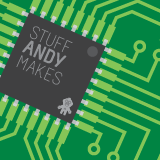Well, we've moved into a new and larger space at the office and we sit at these massive wood and steel desks as teams. Our team decided we needed more "flare" at our desk, so, of course, a big-ass warp core was the first thing that popped into our heads. How hard could that be? The rings of the warp core will be clear-ish fiberglass. The original master, over which we'll make a fiberglass mold for all eight rings, is made of a giant laminated wood block we need to turn on a big lathe.
Turns out, I was wrong about Elmer's Wood Glue: It most certainly does stick heartily to plastic tables. My wife wasn't too thrilled about the weird globs of dried glue on the table, right before a big pool party, so I spent a solid half-hour with a wood chisel scraping off those nasty little glue-scabs. Ick and neat at the same time.
Aside from the general shared engineering tasks, I am in charge of lighting this bad bay. I looked into electroluminescent strips, but it's too expensive and, frankly, not bright enough for our tastes. So, LEDs will be the lighting source of choice on this one. As you can see from the photo above, these inexpensive little 5mm LEDs are plenty bright enough.
The only complaint I have is that they're very directional. At first I thought that I'd just sand them to diffuse the light. But, after some tinkering, I'm going with a sneaky little angled approach: Point the LEDs in a ring at an angle out from the center of the ring so that its light hits the backside of the fiberglass ring in a sorta elongated oval thing. The light from each of the 30 LEDs in a ring will then overlap and make a nice-looking light ring from inside each warp core ring. But, here is my test rig for the LEDs:
The idea with the LED monster above was to see which worked better for diffusing the LED beams better: Point the LED straight out (left LED), or bend it back toward the reflective foil (right LED) which is convex and should spread the light better. Of course, light dies off over distance and the more we bounce it around, the less of an impact it makes. Below is what the LEDs are projecting without blinding the iPhone camera:
So, looking at that photo, you see the reflected LED gets a little black spot on the sun today (Sting) in its beam. The other is brighter, but more concentrated. So, we'll see how my idea of pointing the LEDs at the inside of the fiberglass rings at an angle to lengthen the shape of their beams.
I started out by building the microcontroller and MOSFET circuit, complete with firmware that pulses and fades the LEDs. The speed that the rings pulsate into the middle is set by a potentiometer, at the moment. I think I may add the ability for it to try to pulse to the beat of music. Who knows?
Here is the circuit for the LEDs in action:
The microcontroller is my old favorite, the Atmel AVR. This one is an ATmega328P in the PDIP package. The rings of LEDs (in this video, the lines of LEDs) are powered by 12 volts DC and are controlled by N-channel MOSFETs. Each ring will have a total of 30 LEDs. Each ring will have 10 groups of 3 LEDs plus one resistor all run in parallel on the 12-volt rail. Pretty standard stuff.
Because of the size of the middle section, the matter-antimatter combustion chamber is quite large in our model, we decided to try making a big round thing of foam and then carving that down to the outside shape of the chamber. We'll then (theoretically) cover it in fiberglass and refine the resulting shell after that.
That's it for this update. I'll get more up here as we progress. Thanks as always for following my blog!






